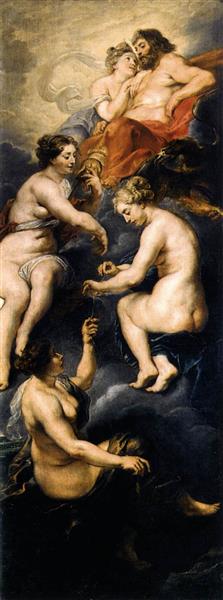Description
Peter Paul Rubens' The Fate of Marie de Medici (1625) is a powerful depiction of the drama and grandeur that characterize the life of the French queen Marie de Medici. This painting is part of an ambitious cycle of works commissioned by the queen herself, intended to narrate her life and her crucial role in French history. In this work, Rubens employs his signature Baroque style, where the majesty of the figures and the dynamism of the composition intertwine to provide a sense of movement and emotion.
The composition focuses on Marie de Médicis, who occupies a prominent, almost central position. Surrounded by allegorical figures and deities, the queen is portrayed with great dignity, showing her importance in the historical narrative depicted. Rubens' choice to include the Queen as a central figure underlines her role as the protagonist of her own story. Marie is depicted in an authoritative and solemn manner, symbolising her struggle and triumph in the political context of 17th century France.
The play of colour in this work is remarkably vibrant, with a passionate use of warm hues evoking the wealth and splendour of the court of the time. Golds and reds intertwine to create a sense of opulence and drama, while blues and greens offer a refreshing contrast. Rubens shows his mastery in the fusion of tones, achieving a harmonious balance that guides the viewer's gaze through the work.
The use of light and shadow is also a significant element in the work. Rubens applies subtle chiaroscuro, illuminating the figure of Mary and the surrounding figures in a way that reinforces their centrality and power. This not only helps to direct attention to the protagonist, but also communicates a sense of divinity, suggesting that her destiny is aligned with the grand and monumental.
The setting in which Mary is depicted is equally symbolic. The cloud that supports her, together with the allegorical figures representing peace and war, reinforce the idea that her destiny is intrinsically linked to the tumultuous events of her reign. Among the characters surrounding her, one can identify figures from classical mythology, such as representations of Fortune and courage, which underline the heroic nature of her life. This interweaving of mythological and realistic elements is characteristic of Rubens' style, who often used mythology to enrich the context of historical figures.
The background of the work further reveals Rubens' genius. The way the figures are intertwined, the use of space on the canvas, and the arrangement of elements on a diagonal plane all contribute to a visual narrative that captivates the viewer. This compositional dynamic is not only an aesthetic delight, but an invitation to reflect on the queen's own story and the complex circumstances of her life.
The Fate of Marie de Medici is not only a Baroque masterpiece, but also a profound exploration of female identity in a context of power. Rubens, through this grand and emotive depiction, not only celebrates the life of Marie, but also questions the role of women in politics, making this painting a timeless reflection on fate and personal struggle in a world shaped by forces larger than oneself. This canvas remains a powerful testament to Rubens’ talent and his ability to weave history and mythology into a captivating visual narrative. As such, it stands not only as a testament to the life of a queen, but also as a symbol of women’s ability to shape history, even in the context of the most daunting challenges.
KUADROS ©, a famous painting on your wall.
Hand-made oil painting reproductions, with the quality of professional artists and the distinctive seal of KUADROS ©.
Painting reproduction service with satisfaction guarantee. If you are not completely satisfied with the replica of your painting, we will refund 100% of your money.

